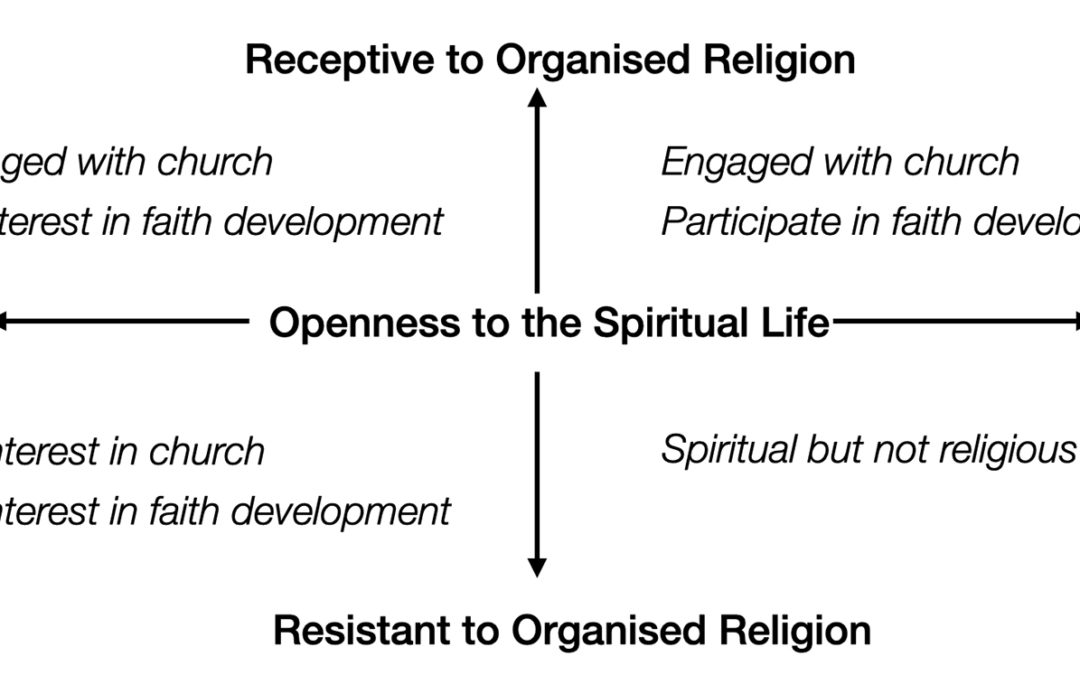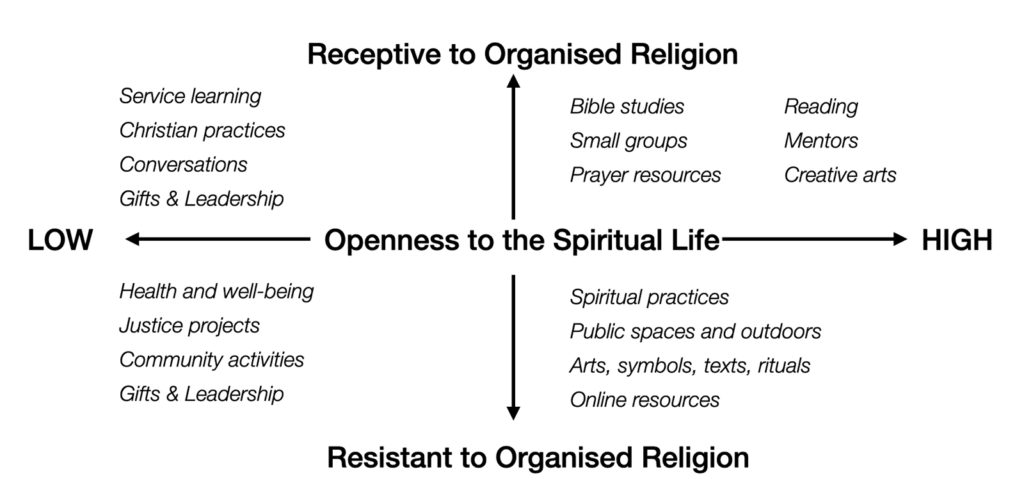Last Saturday I spent time with a church council, and a perennial question was raised. “Why aren’t more people interested in Bible Study?” We were discussing what it means for a church to see faith formation at the heart of its life together. Is Christian education just for the super spiritual? Are the disciplines of prayer only for the saintly?
US Catholic education John Roberto helpfully speaks about faith formation for all people in their differing ages and stages of life. In 2010 he gathered about a dozen Christian educators from across mainline US churches and produced the following four scenarios for faith formation. Note that I have adapted his language.
The vertical or Y axis is about people’s openness or otherwise to participating in organised religion. (eg. church). People above the line are open to participating in church activities, those below the line are not (at this point in time). The X axis is about interest or openness to spirituality or explicit matters of faith. The quadrants indicate four kinds of people, or more accurately, four differing opportunities for engaging people in faith formation at any one point in time.
Roberto says that most of what the church offers is in the top right quadrant – activities with the church for people who want to grow spiritually. Bible study groups. Prayer groups. Retreats. Book clubs. What about those in the top left, who are happily part of the faith community but show little or no interest in such activities? How about the bottom right corner, those who don’t think you need a church to explore spirituality?
The language of faith formation is interesting here. Previously we might have spoken about ministry ‘below the line’ as evangelism or pre-evangelism. Roberto says that all of this is faith formation. People take many kinds of pathways in and into faith, and for many of us there is no simple ‘before’ and ‘after’. Many people outside the church have a very conscious experience of spirituality, and it is unhelpful to assume that they don’t. God is alive and well in the world. What matters here is genuinely engaging with people where they are at, not where we are at, in exploring what it means to experience a deepening relationship with God and a journey towards life in all its fullness.
In Faith Formation 2020, Roberto suggests a range of formation opportunities for each group or scenario. My table below is slightly different (but not unrelated).
Top right – Religion = high, Spirituality = high
Most churches offer activities or resources for spiritual growth in addition to worship services. However there are always opportunities to consider the breadth and depth of these. Seasonal study series. Daily devotional resources. Prayer triplets meeting over coffee. Short or longer term mentoring. Hosting a regional biblical teaching weekend.
Top left – Religion = high, Spirituality = low
For those on the left of the Y axis, the spiritual is part of everyday life, yet rarely articulated. Faith-in-practice is the key. A work party where there is conversation about why we serve and what we are learning. Participating in Christian practices such as hospitality, generosity, environmental projects, social justice – all permeated with faith conversation, some prayer, and worthy questions. Developing leadership and gifts with the awareness that we are innately spiritual.
Bottom right – Religion = low, Spirituality = high
An outdoor labyrinth. An art exhibition. A prayer garden. Meditation in the park. Online resources for spiritual practices. Celtic or Creation-centred prayers. Timeless quotes from spiritual leaders through the ages. Spiritual expressions that are embodied, not just verbal. Partnering for multi-faith events. Nurturing the imagination and the senses as spiritual pathways.
Bottom left – Religion = low, Spirituality = low
The well-being of people and the planet are integral to our faith and spirituality. Many of these people willingly participate in seeking fullness of life for others, themselves, and our environment. When we grow into authentic selfhood and community, we are growing spiritually. As such growth is encouraged, there is opportunity to name and explore our connection with the God of life and God in life.
It would be easy to misunderstand this as labelling people. This is not some kind of spiritual personality test or formula! No does it suggest that people do not grow or change. Rather, here is an opportunity to think and act outside the box when it comes to fostering growth in faith. These quadrants may be seen as stepping stones, not as containers.
In all of the above, faith and the spiritual journey may be seen as part of all of life, of the whole person. What makes the difference is intentionality in providing experiences and resources to form people’s faith, and providing spaces that are relational and conversational, and well as the freedom for people to explore in their own space and their own time.
 John Roberto’s book Faith Formation 2020 is a free download here. Check out his other excellent books for free there as well.
John Roberto’s book Faith Formation 2020 is a free download here. Check out his other excellent books for free there as well.

